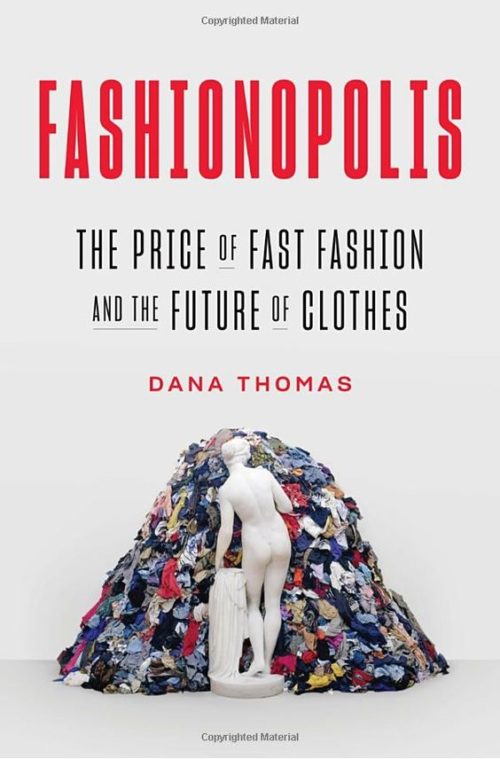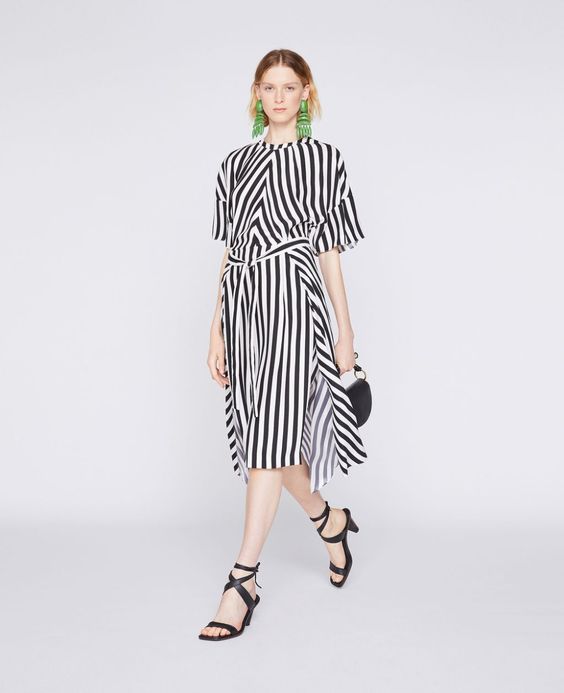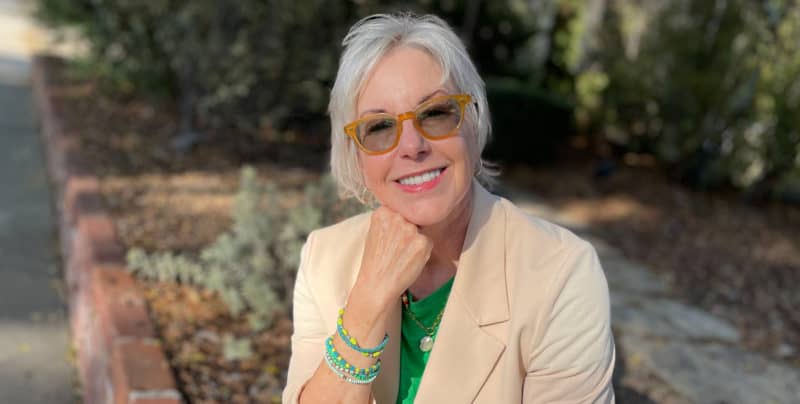Monday Miscellany: Reading, Pondering, Watching
First, on this Memorial Day, a word of thanks and remembrance for those who lost their lives while serving their country in the armed forces. We are ever grateful.
Fashion’s Way Forward?

Over the last few years, “sustainability” has gone from a fringe concept to a more driving force in fashion. It’s been well documented that fashion, especially fast fashion, has a huge negative environmental impact. Designers and brands are feeling the pressure from consumers to reduce that impact, and have been touting their various initiatives to produce clothing more ethically and sustainably.
But there’s still a lot of smoke and mirrors. Some efforts touted as “sustainable” really aren’t, or can’t be verified. (I’ve seen the term “greenwashing” used to describe this effect.) And it can be hard for most of us to make that determination on our own, especially when supply chains are so convoluted.
I spent several hours over the weekend reading Fashionopolis: The Price of Fast Fashion and the Future of Clothes by Dana Thomas. I’m about 2/3 of the way though, and so far it’s a fascinating (and uplifting) read. Thomas profiles a number of brands, manufacturers, and designers who are finding new ways to do business (profitably) that are more sustainable and transparent. And best of all, they’re making it local again…bringing manufacturing (but modern, ethical and more environmentally friendly manufacturing) back home.
Will Sustainability Save Fashion?

It will be interesting to see how these brands and makers (both large and small) are able to weather the current pandemic and economic downturn. I’m hopeful that what seems to be a renaissance of sorts isn’t set back irreversibly. I think we will see a period of upheaval in the fashion industry for some years, but my fingers are crossed that the future looks more like what Li Edelkoort and Thomas have glimpsed than what we currently have.
Reading “Fashionopolis” is also making me cast a more discerning eye on my own shopping habits. I’ve always been a believer in “buy less, buy better,” but haven’t always walked the walk. Sometimes I get pulled off that path by shiny objects at pretty prices, or just the thrill of something new. I’m committed to doing better in the future.
How would you like to see fashion change? Would you pay more for clothing produced locally and ethically?
We’ve Been Watching…

I’ll admit, I wanted to watch “The Great” on Hulu just for the costumes, but we’ve really been enjoying this series. Elle Fanning stars as a young Catherine the Great in this irreverent, bawdy, and cheeky take on the imperial court of 18th Century Russia. And yes, the costumes are good too.
(Image source.)

Stay in touch
Sign up to be notified of new posts and updates from une femme d’un certain âge.


Such a difficult subject. Especially for me. Like you said, I want to but get pulled off the chosen path by lovely new things. I banned H&M, Zara, Mango and Primark and if it is really cheap I don’t buy it. But I could do so much better.
Greetje
A response from Eileen Fisher re my comments about her company’s investment in China: “Regarding items Made in China, I can confirm the progress we have made: Over the past 2 years, we have decreased our Made in China goods from 70% to about 30% of our overall production. That 30% comprises 4 factories where we have a high degree of confidence in their environmental and social performance.“. I question their “social performance” since China is a notorious human rights abuser, having starved to death millions of its own citizens, but at least Eileen Fisher is going in the right direction.
Interestingly, I also contacted Eileen Fisher regarding country of origin/manufacturing. I also am looking for clothing not made in China. This is part of their reply on April 22, 2020: “We support US manufacturing and sewing many of our core fabrics in New York City or Los Angeles. But some silks, knits and specialty pieces are made overseas, closer to the materials and expertise needed to create the highest quality clothes. Our Silk Georgette Crepe, for instance, is woven in a region of China known for its vibrant silk tradition. We sponsor training programs in China and elsewhere to teach workers and managers how to advocate for themselves and improve conditions on the factory floor. We also make it a point to partner with factories that share our values—especially those that meet the global labor standard SA8000.”
Well I’m quite old (66) and not as well off as readers of this blog seem to be . Also I love clothes but haven’t much liked fashion since the ’80s/’90s partly because the colours have rarely suited me – and I simply don’t fit this season thing . I have bought ethical/sustainable/eco fashion on sales or when I could afford the full price and discovered various useful facts ; firstly organic cotton lasts much longer than non-organic so easily pays back on the initial outlay – so long as it has no lycra/spandex/elastane in it which eg increases bagging at the knees and then breaks up to show horrible ends of the elastic thread thru’ the fabric (but then if I like an item of clothing I want it to last 10 yrs and not 2) , eco fashion doesn’t ask you to dry clean everything & oddly the dyes used do not fade as much as the usual ones . I also buy from charity shops – you call them thrift shops I think . If anything the standard of clothes donated has gone up in this century , perhaps because no one male or female is taught mending or button replacing anymore ! But then upmarket fashion is often no better quality than so called cheap labels – and often no more ethical . I read that eg Primark isn’t a bad employer or manufacturer compared to labels like Calvin Klein (which often uses the same factories and workers at the same wages) , it is just cheaper . So Primark’s marketing strategy is to sell lots of cheap things , designer labels sell less at higher prices – neither are truly ‘exclusive’ .
I hear you. I used to buy “made in Canada” labels, from factories in Montreal. When the garment industry shifted overseas, fit issues made buying clothes a nightmare for me. Domestic clothing makers knew Canadian sizing. Now I struggle to find a fit that doesn’t exist. Sleeves and torsos are too short. Women apparently aren’t supposed to have hips and a waist. The colors are mostly not suited to my English rose complexion. Synthetic fibres irritate my skin. Winter outerwear is made for winter in the tropics. So unless one can spend hundreds of dollars on each garment, nothing will look as good as it did thirty-plus years ago, when it was easy to find quality and fit at reasonable prices in department stores. Those don’t exist any more either, except for one, and it carries ill-fitting junk that doesn’t suit my complexion.
Clothing is disposable now, but this isn’t working for consumers, garment workers or the environment. Thinking of going on a buying strike, because I’m fed up with this entire industry. (But I’d better not change weight. This, and items that wear out are the only reasons I buy new clothes now.)
Glad you raised this topic. I’ll look for the book via my library!
I think we are all seeing how “shiny ” things have dominated the economy! Especially clothing, jewelry,
Cars, etc! I have loved wearing clothes that feel good and saying NO to trendy things during this time of the virus….I hope I can continue to buy less and donate more……
I’m reading Fashion and age, by Julia Twigg, a U.K. Professor of Sociology. Reads like a text book, but fascinating. And I read The Triumph of style, a older book , using historical paintings to explain style, also good. I’ve read a couple of books on the subject of fast fashion, my thoughts, we need to pay more for better quality probably, But the fashion industry’s goal is to sell things, firstly, always remember that. If we want to wear our clothes for ten years instead of one, I’m guessing, they will start to manufacture something else ( dog costumes?) where we will buy more freely.
While I have enjoyed your blog for years, I am a firm believer in Fewer but Better. Frankly when I see that a post is all about more things to buy, I stop reading…I couldn’t afford the great quantity of clothing and accessories you have. It would be great to see a more responsible focus. That said, I keep coming back. Love your features on travel, food, style, aging, etc.
Agree with many of the comments. showing the Stella McCartney dress is totally out of my price range and probably for many others. Most Americans buy way too many clothes and the quality no matter whether top brand or low has become awful. I used to sew a lot but the quality of fabric again is not what it used to be. Years ago I bought beautiful woolen and linen, etc. skirts, jackets, slacks that lasted for years…no longer. Am very careful about laundering my clothes…use delicate cycles, hang almost everything and iron almost everything.
Do enjoy your features on travel and packing easily. Thank you.
That dress is out of my price range too. 😉 I was just using it as an illustration of one of the designers mentioned in the book. I think part of the problem of fast fashion and the “race to the bottom” is that it’s made producers shift to cheaper fabrics, as that’s where the customers are. It’s kind of a vicious cycle…the more consumers expect clothing to be cheap, the more producers will chase that. I’m not saying everything has to be high-end, and neither is Thomas in the book. Sometimes sustainable is also more cost-effective, and it’s just a matter of re-thinking how things are made. It’s also about reducing waste, and there’s some amazing innovation going on around recycling fabrics.
Thanks, Susan. Agree that customers want lower prices and it is a vicious cycle. Trying to be careful with my purchases and take care of my clothing and shoes!! By the way how many of us have husbands that can’t seem to understand our love of shoes??? Mine could care less about clothing but for some reason my shoes drive him crazy :):)!! Have a great week!
I was lucky to be able to see the Fashioned from Nature show at the Victoria and Albert Museum a couple of years ago, which focused on fashion’s impact on the natural world and what some fashion companies are trying to do to remedy their production. https://www.vam.ac.uk/articles/the-future-of-fashion.
I’ve also been trying to “shop my closet,” repair clothes when needed, and shop (online) consignment if I really need/want something. It’s so much easier (and tempting) to just shop new, so that’s the challenge for me!
On another note, I receive your emails with the link to your blog, and when I click on it I have been getting the message of a suspicious link for the last couple of weeks.
Hi Alexis, thanks for the note about the “suspicious link” warning. This seems to be caused by an aggressive spam filter in one particular email platform. My links ARE safe. If you add [email protected] as a “safe” or “preferred” sender, that will sometimes eliminate the error message.
And thanks for the link to the V&A exhibit, would have loved to have seen that one!
I have been shopping at the ‘largest consignment store in North America’ which is called Thredup. You can find almost anything and also request that items are ‘like new’ or ‘new with tags’. One item I bought was a long, velvet jacket Italian made jacket that was originally $800 for less than $100. Blouses that are $70 in the store are usually around $25. You can use the filters to find specific colors and sizes. When I am done with them I take them to my consignment store, give them to a local charity that sells good quality clothing or donate them to a women’s shelter.
I love the book recommendation and will borrow from my local library or download on Kindle (another way to cut down on waste). I love your blog and appreciate the thoughtful insights into self-esteem and self-knowledge the most. While I like your style pieces very much I have been trying to limit my exposure to” buy this buy that” blogs. I can very easily get sucked into the black hole of needing more. I have started to buy more thrift and consignment clothes and also cut down on new items of any sort, trying to be content with what I have. One of the big lessons of this pandemic for me has been how little I really need to look good. Please keep exploring this idea of needing less. My issue with much sustainable clothing is no petite sizes and very full, blousy silhouttes that swamp my 5’1″ 112# frame. I would appreciate some guidance on sustainable brands that fit a wider range of sizes and styles. Thank you for what you do.
Part of feeling like I need more is the result of the things I have that don’t fit well or are unflattering, because they are scaled to much taller people. Debra, I agree that little of quality is offered for short people. I think that is partly why I love shoes.
There’s an app for that! Good on You rates brands based on ethical and sustainable values.
The whole Made In Italy except by Chinese not Italians leather goods story has been so disheartening to me. It seems you can’t trust anyone.
A very important and challenging topic! I avoid fast fashion and I’m making a concerted effort to boycott items made in China, though that is very difficult to do. I also love thrift store shopping, so much of my wardrobe has been bought second hand. Since I rarely shop for clothing online, the Covid shutdown has greatly helped me achieve my goal of buying less this year!
Hello To All: There is something reassuring and polite about those who dress well and carefully in both professional and casual settings. It is a respectable way to go through life. It seems to promote both a personal sense of self worth as well as speak of the hope for all to be aware of others. While I don’t condone fast, wasteful fashion, I still think there is a place and always will be for the lower price range of the fashion scale. Here a teen can try out a new style without a huge $$ risk. One can buy a pair of shoes that only the young foot could endure and learn the lesson that even young feet don’t need some of those shoes. As one who sews may I suggest a couple of quick sewing ideas that most of us can do (we of a certain age all had some sewing in school I think) or we can take these to an local talented tailor or seamstress for help: 1. Change the buttons on a blazer or coat. It will give it a whole new look and style. 2. Shorten said blazer or coat, will also update it almost instantly. 3. Get back into sewing. Before you buy expensive and quality fabric (lots of good on line sites for this), you will evaluate whether you really need it, and want to invest the 10 to 20 hours needed to produce a quality garment or even the 2 or 3 for something quick and easy. Ok, I know many of you don’t want to sew, but if your home ec teacher is still a terrorizing problem after all these years, you might want to try again. Lots of good on-line tutorials.
I hope Susan will keep posting about fashion. It is helpful and inspiring and really just fun and an escape for all of us. I think we should all try to look our best. Suggestions, helps, hints, I am all for them from someone with Susan’s taste and experience. I love this blog!
So funny: the Home Ec teacher who did bag searches before leaving the class, to make sure we didn’t take our projects home for our mothers to finish. I quit Home Ec after the compulsory years, even though I had won the sewing award. I just didn’t see the point in embroidering aprons that I would never wear, even though I was good at it. Some of us donated our projects to our dogs, who found them quite useful as custom-embroidered bedding. I took up Latin instead.
I’m afraid the “sustainability” movement is just another fad. There are plenty of people who still drive large gas-guzzlers, water their green lawns in the desert, buy single-use items with their excess packaging and who will never give up cheap fashion and the shopping high that comes with it. I’m glad you are optimistic, but I’m not.
Very difficult in our small nation of 5 million to purchase much that is not made offshore. There is a big push here to buy New Zealand made but between the cost and the selection offered I fear it won’t fly. As a Cool Winter I find it very challenging to find any colours to suit and this seems to be on repeat season after season. There are some overseas companies like Kettlewell but they either don’t ship to NZ or the cost is prohibitive. Really hoping that some lessons can be learned post Covid.
So glad you are interested in more sustainably made clothing, and also that you are reflecting on your own shopping habits.While we can hold clothing manufacturers to account for how they make their clothes, it seems that our own individual actions can have a bigger impact: Don’t buy so much stuff. Many of your readers seem to be saying similar things, that we don’t all have to or need to buy so many articles of clothing. As a long time reader of your blog, I have become increasingly dismayed at the cost and amount of clothing you seem to buy. We are living in a more casual time than our mothers lived through, and many of us in this age group may not even be working outside the home now. I want to look good too and I love clothing, but it just seems wrong to spend so many of our resources on clothing, especially as we are all going through this pandemic. I do enjoy your blog.
Fashion can be a nice diversion in a pandemic. It’s good to find a blogger who posts thoughtful commentary without sounding tone deaf to the situation at hand. Thank you Susan for always trying to find the right balance. Most of us don’t need to shop at this time, whether we can afford it or not. We need each other, for inspiration and compassion.
I consider myself blessed in that I have never been a shopper. I’ve never seen the appeal of wandering around malls & stores looking at (or buying) stuff I don’t need & have never needed to entertain myself by shopping or buying new things. Of course that’s been bolstered by the fact that throughout my working life my career usually required jeans, a hard hat & steel-toed boots more than it ever did “fashion” clothing. When I retired I thought, great, now I can buy some of those pretty things I’ve looked at but resisted buying because I had nowhere to wear them — but in our retirement my husband & I still prefer doing things that require jeans & I discovered I’m just as deathly bored by shopping as I ever was. I do love thrifting — it’s the ultimate treasure hunt — but when I look at things like the Stella McCartney dress you show, which I **could** afford if I wanted it badly enough, just the thought of spending $2167 Cdn (yes, the exchange is that bad) for a dress when so many people are suffering terribly through this pandemic makes me physically nauseous. I know I can’t solve the world’s problems by myself but I can do what I can, & not filling my closet full of clothes I have absolutely no real need for is one of them. I don’t know how this will translate post-pandemic: I try to buy local whenever possible already & I don’t like shopping on-line because I prefer to physically see & try on a garment before buying it. I like looking well put together but have never had much interest in fashion beyond that. Give me a nice-fitting pair of jeans & a tee-shirt, good leather boots, a classic leather moto jacket & a bunch of wild jewelry & I’m happy. It’s going to be interesting to see how the retail market changes — or if it does — & how that market adapts. To be honest I wish we’d all become more interested in what’s in people’s hearts & minds than on their bodies in the coming years, but I don’t hold out much hope 🙂 And thank you for this thoughtful — & thought-provoking — post, Susan. Just asking the question “what next?” is a good start.
Such interesting comments and love that there are readers commenting from different areas of our world. ;My children 28 & 23 often tell me to spend money on experiences not on things. My DIL shops thrift exclusively, is always well dressed as are her kids. Any new toys are gifts and they plan to rent for the long term so they can walk,public transit to appointments, work, errands in their urban ‘hood.
Disposable shopping affects furniture ( hello IKEA) sad that our solid mahogany dining set ( now referred to as brown furniture) would fetch just a couple hundred dollars when we paid over $6;000.00 for it ( on sale) over thirty years ago! Nobody wants it anymore and the much lauded Canadian manufacturer( Gibbard) has gone out of business. My mother was a window dresser for a large department store and had the chance to purchase her living room furniture at a good price when she married. When we were married (44 years ago)my parents gave us the furniture which I had recovered several times, it’s still in our ( little used) living room, still looks great! One of my children will inherit it when we break camp over the next two years. The frame is solid hard wood and every upholsterer who has worked on it has offered to buy it saying ‘you just can’t buy this quality any more’! I think decorating should also follow the ‘buy best, buy less’ theory too.
I am making a concerted effort to not purchase clothing manufactured in China. My son spent five years in Beijing and spent some time with the Uhyghur people, an ethnic muslim minority in western China. The Chinese have rounded up this population and placed millions of them in reeducation camps attempting to wipe out their customs and religion. Some horror stories have even emerged that this population has been used for organ harvesting. The numbers of Covid deaths in China is so incredibly inaccurate and, the truth is, they did little to nothing to stop the disease. Italy, where my daughters have lived for 9 years, has been decimated. In one 24 hour period over 985 people died in Italy, a country the size of California. China did not stop flights into northern Italy where Chinese silk merchants flew in and out prior to the Milan fashion show. While the people in Hubei province were confined to their own region the flights to other countries were never halted.
Great book! I learned a lot, was appalled and inspired! It will be interesting to see what changes as we work our way out of the pandemic.
How many of us know there are goods that indicate they are manufactured in Italy and the company is owned by the Chinese and import Chinese workers (that’s why the virus was so wide-spread in Italy; Chinese workers returning from the Chinese New Year to their Italian jobs)…we are led to believe these are higher quality items since they are manufactured in Italy. A read this years ago in a reputable magazine and it absolutely surprised me and opened my eyes.
I have dual Italian and American citizenship and when this pandemic started many Chinese tourists were annoyed with Italians who served them “la cena” wearing masks and accused them of xenophobia. Now I’m afraid it will be much worse. The Italians blame the Chinese totally for what’s happened there.
I checked our library system for the ebook Fashionopolis, sadly it isn’t available and branches are closed. I haven’t tried any of their sustainable options yet from Everlane, incorporating recycled fabric into tops, adding organic cotton tees and fleece/outerwear made of recycled plastic bottles. I’ve done a minor closet and drawer purge of things which aren’t good enough to donate because my city offers fabric recycling and the thrift stores are closed anyway.
This is the first time I’m commenting, and I wanted to share a view that is slightly different from some others. I am retired and make a concerted effort to buy fewer clothes. I also LOVE to shop — or just go to stores and browse. Fashion blogs have actually helped me buy less. They’ve taught me to focus more on what I really want and need, and to ask how something will fit with what I already have. They help identify better alternatives than I might find myself.
I am a young 80, still marathoning. Just learning to sew because I like lining and bound buttonholes and beautiful fabric.I am saddened by the many nationalist comments here. It too bad our government foments this. This is the reason why global issues such as climate change will never happen. In modern times nationalism killed 6 million Jews and millions of others. It’s takes international cooperation to solve these challenging problems facing all mankind.
Hi Roseanna, I didn’t mean to imply that we shouldn’t buy products made overseas. After all, there are sweatshops here in the US too. And I agree that all nations will have to work together to combat climate change and improve economic conditions.